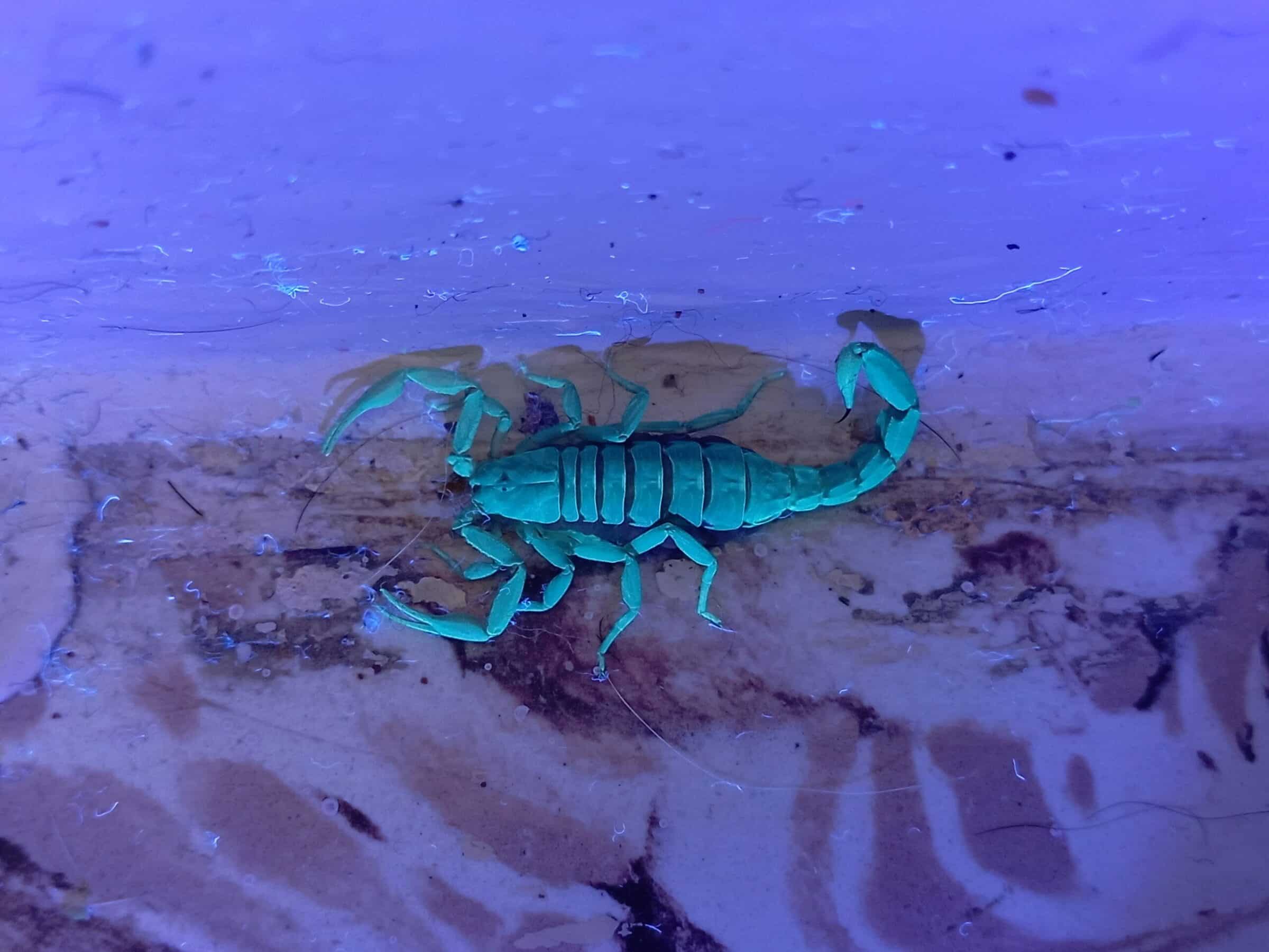 Evolution
Evolution
 Intelligent Design
Intelligent Design
Fluorescent Animals: Can They Be Darwinized?

Perhaps in our younger days many of us, like me, played with black light, shining those eerie purplish-blue bulbs at each other and chuckling at our glowing teeth and eyeballs. Unlike bioluminescence (see “Let there be bioluminescence”), which is a property of generating light through protein interactions, fluorescence results from materials that absorb light at one frequency and re-emit it at a different frequency. A photographer friend of mine specializes in photographing insects and scorpions. I’ve watched him take out his black light at night in the desert, finding scorpions that glow blue-green in the dark. From jellyfish to bananas, and from corals to chlorophylls, fluorescence is common in biology. Does this property have a function?
Whether fluorescence has any adaptive value was the subject of an interesting recent article in PNAS by four scientists, “The function and consequences of fluorescence in tetrapods” (Nicolai et al.). Before getting into their analysis, a brief review of terms about light is in order. Light, as understood by physicists, includes any electromagnetic radiation, from the shortwave gamma rays to long-wavelength radio waves. What we understand as visible light is an extremely thin bandwithin this spectrum. Materials either absorb or radiate light, or both. How does biology engage with these forms of light?
- Thermal radiation is a property of every material above absolute zero (0°K). Due to metabolic reactions, all living organisms generate heat (infrared radiation), as can be demonstrated with an infrared camera.
- Incandescence refers to emission of visible light by a material when its temperature is raised above the Draper point of 977 °F (525 °C, 798 K). This blackbody radiation begins with a dull red glow and proceeds to white and blue as the temperature increases. Land organisms do not normally emit incandescent light unless they are caught in a forest fire.
- Fluorescence is re-emission of absorbed light at a different frequency, usually a longer wavelength. Fluorescent light is emitted by fluorophores — chemicals that fluoresce. Fluorescence is common in living and nonliving materials.
- Phosphorescence is chemically similar to fluorescence, except that phosphorescent materials continue to emit light for a much longer time after the external light that triggered the radiation is removed. It is rare in biology except when an organism has ingested phosphorescent minerals such as calcite.
- Luminescence is the generation of light not caused by incandescence and occurring at a temperature below that of incandescent bodies. (Star brightness is spoken of as luminosity and is produced by nuclear reactions in stellar interiors.)
- Chemiluminescence is the emission of light through chemical reactions without any prior absorption of energy.
- Bioluminescence is chemiluminescence by biological organisms. The emission of light is achieved through interactions of biomolecules, such as luciferin and the enzyme luciferase.
- Structural color is the intensification or cancellation of particular wavelengths of light by geometric properties of the reflecting material.
The Light of Life
Since some UV light reaches the earth’s surface (about 3 percent of incoming solar radiation), it can make some animals glow in the dark with biofluorescence. Against this backdrop, we can ask why so many animals fluoresce.
Unlike bioluminescence, which seems to have demonstrable functions in animal communication (fireflies), predation (deep sea angler fish), or camouflage (fish that emit light to blend with surface light), fluorescence does not present an obvious adaptive function. Evolutionary biologists have proposed adaptive stories about fluorescent organisms in the ocean but it becomes more difficult to explain for tetrapods on land.
Nicolai et al. present a photograph of various birds and mammals that change color dramatically between visible light and UV light (Fig. 1). The parrots, especially, glow with different colors than seen in visible light. The authors are puzzled about fluorescence in terrestrial animals.
The visual appeal of vibrant, fluorescent colors to humans has led to the description of fluorescent patterns across the tree of life. These findings have led to breakthrough applications, such as the green fluorescent proteins (GFPs) used extensively in molecular biology. With so much known about how GFPs work, it is remarkable that the functional significance in the animals themselves remains unclear. However, impressive demonstrations of fluorescence in dark rooms with intense, unnatural excitatory lighting may encourage an outsized impression of their visual significance (Fig. 1). Indeed, many terrestrial tetrapods, in contrast to aquatic and marine animals, occupy habitats that are particularly suboptimal for the perception of weakly re-emitted fluorescent wavelengths. Furthermore, while the framework to investigate a potential function of fluorescence is well established in (marine) (in)vertebrates, this seems less so in tetrapods, as highlighted by an explosion of publications that describe fluorescence in tetrapods and often explicitly or implicitly link the presence of fluorescence with sexual selection and communication. [Emphasis added.]
The authors complain that some biologists jump the gun by concocting adaptive stories about biofluorescence in land animals. The attitude seems to be, “If it exists, it was the result of natural or sexual selection.” The scientific community should expect higher standards of investigative rigor.
Recent years have seen a stream of articles reporting fluorescence, ranging from frogs, platypus, to even fully terrestrial organisms such as flying squirrels, often explicitly or implicitly linking the presence of fluorescence with sexual selection and communication. However, many of these studies fail to consider the physiological requirements of evolutionary stable signaling systems, the environmental dependence of perception, or the possible adaptive role of fluorescent coloration in a noncommunicative context.
Communicating with Color
A rigorous explanation of biofluorescence for communication, for instance, would require elucidating the physical specifications in both sender and receiver. The fluorescing animal must have the genetic code to produce fluorescent materials, and the receiving animal must have the ability to perceive the color change and respond to it.
The intuitive appeal of fluorescence as a unique form of color-based communication must be tempered by a realistic understanding of its limitations. Indeed, fluorescence is so ubiquitous in animal tissues that it should be considered the norm rather than the exception. Therefore, attributing specific functions to fluorescence requires exceptional evidence supported by a rigorous framework.
The authors point to work by Marshall, Johnsen, and Mazel, who presented five criteria for determining whether a communication function exists for biofluorescence.
- Identifying a fluorescent compound with known excitation and emission wavelengths.
- The compound must be visible.
- The fluorophore must be exhibited in a suitable light environment.
- The color shift must be perceptible by potential viewers.
- The receiver must exhibit a behavioral response.
“This last criterion, in particular,” they say, “is rarely tested, and more behavioral assays that manipulate fluorescence are needed.” Without meeting these five criteria, biologists might have to conclude that biofluorescence is a mere artifact with no functional significance. “More importantly,” they say, “the idea that fluorescence may simply constitute an indirect by-product of selection on other traits is often not explored.” Perhaps, though, selection has nothing to do with it.
Enter Design Biology
Design advocates could go either way. Functional or nonfunctional? That’s a design inference question. And when they speak of “physiological requirements” for a signaling system, the bioengineers in the ID community should perk up their ears. It could be that biofluorescence is a byproduct of proteins common in fur, feathers, and skin. Glowing teeth in black light may be an artifact of the properties of apatite minerals in our enamel. But if fluorescence does serve as a signal between animals, that would open new opportunities to perform rigorous studies on ecological relationships according to the five criteria in the list.
Once again, design thinking promotes rigorous scientific investigation, while Darwinism explains things away with intuition. There is a good likelihood that design scientists will find functional significance in biofluorescence. Why? Because in other contexts, it is already known. The authors did not mention biofluorescence in flowers. Colors unseen by human eyes, but visible under UV, can be detected by pollinators. The flowers guide honeybees to the nectar with fluorescent runway lights.
The authors give scant attention to another design possibility: structural color. “One study suggests that mammal fluorescence may be the result of structural color,” they say, “although there is neither evidence supporting this strong claim nor a plausible mechanism for it.” There is probably more to this possibility than stated, however. We know that butterflies and birds use photonic crystals — intricate geometric patterns in scales and feathers — to intensify reflected light at specific wavelengths and interfere with others. Design scientists could see if the molecules fluoresce and intensify UV light in the dark for receivers of such signals. If so, irreducibly complex molecular machines and genetic codes could be predicted to exist in both the senders and receivers.
Hidden Possibilities
As predominantly diurnal mammals with eyes tuned to wavelengths between 380-700 nm, we humans could be missing a world of information being communicated in the biosphere at night at wavelengths beyond our range of vision. As inventors have already done with compasses for magnetic navigation and infrasound detectors for listening in on the undersea symphony, our intelligently designed instruments could expand the horizons of biology and open up new vistas of photonic design all around us. Some Darwinians may content themselves to explain away bioluminescence with their customary naturalistic glasses and narrative glosses. Light comes to those who take off the blinders of consensus and open their eyes to other possibilities, like intelligent design.
